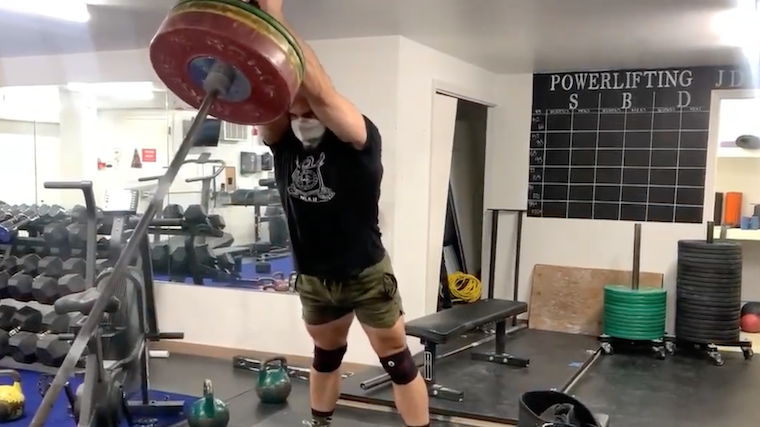There’s a right way and a wrong way to use every piece of equipment in the gym. You wouldn’t try to do biceps curls with the leg extension machine or use the pec-deck to work your inner thighs. And you wouldn’t wedge one end of a barbell in a corner and do exercises while holding the other end, right? Well, wait a sec on that last one.
By upending the bar and planting it into a pivoting sleeve, you can begin landmine training. This opens the potential for new exercises, unique leverages, and more stimuli for muscle growth that even dumbbells can’t replicate. It also introduces 360 degrees of rotational challenge, making it a top choice for building total-body strength in athletes of any sport or lifters who want to look and move like athletes.
Here are some of the best ways to use a landmine for head-to-toe strength, size, and conditioning.
Best Landmine Exercises
- Landmine Goblet Squat
- Landmine Belt Squat
- Landmine Reverse Lunge
- Landmine Single-Leg Romanian Deadlift
- Landmine Single-Leg Hip Thrust
- Landmine Single-Arm Row
- Meadows Row
- Landmine Floor Press
- Landmine Overhead Press
- Landmine Lateral Raise
- Landmine Curl
- Full Contact Twist
- Landmine Hot Potato
- Landmine Clean and Press
Landmine Goblet Squat
The goblet squat, sometimes called a landmine front squat, is one of the most fundamental exercises you can perform with a landmine. By supporting the weight in front of your body, the weight is transferred to your legs through your arms, shoulders, upper back, and abs, while your spine and lower back avoid any significant strain.
The landmine’s natural range of motion being arc rather than a straight line also reinforces proper body positioning by encouraging (a.k.a. “forcing”) your torso to remain upright as you lower to sufficient depth. The bar is held to your chest, which physically prevents your upper body from collapsing forward.
How to Do the Landmine Goblet Squat
Getting into the starting position is often a limiting factor, so it can be useful to begin with the weight on a bench, box, or step. With your feet wider than shoulder-width apart, squat down and support the end of the bar with both hands near your upper chest.
Keep your feet flat and your shoulders pulled back as you stand upright. Be sure to keep the bar tight to your chest, as the bar’s path will be upwards and slightly forwards. Don’t let the weight drift away from you, which could increase strain on your shoulder and elbow joints.
Benefits of the Landmine Goblet Squat
- The landmine goblet squat builds the quadriceps, hamstrings, and glutes with minimal lower back stress.
- It reinforces basic squatting technique which carries over to other squat variations, making it an ideal option for beginners.
- The movement encourages a deep squatting position, which can help to improve overall hip mobility.
Landmine Belt Squat
The belt squat is a very useful, but very large, machine used to train the legs with heavy loads and nearly zero lower back stress. Rather than supporting a loaded bar across the shoulders or upper back, the weight is distributed almost directly across the stable pelvic girdle with no compression of the vertebral discs.
By combining a landmine with a basic dip belt (more commonly used for dips or pull-ups), you can reap the same benefits without needing to dedicate 25 square feet of gym space to one specialized machine. The landmine belt squat is an excellent addition for lifters dealing with wear and tear on their lower back or any lifter looking to finish their intense leg day with high-rep burnout sets.
How to Do the Landmine Belt Squat
Set up two stacks of steps (using bumper plates is common) with a landmine in the middle. The height of the steps will determine your squat depth. You should be able to reach a deep squat position without the weight resting on the ground, so adjust as needed. Loading the bar with smaller-sized plates, like 25-pounds instead of 45-pounds, will also increase the range of motion.
Stand on the steps and secure the dip belt around your waist. Lower into a deep squat position and attach the belt chain around the barbell near the weights. Pull your shoulders back, brace your abs, and keep your feet flat as you rise out of the squat position. The loaded bar should be suspended by the chain throughout each rep. When the set is over, lower into a deep squat and detach the belt from the weight.
Benefits of the Landmine Belt Squat
- It’s shown to significantly reduce stress on the abdominals and lower back while training the quadriceps and hamstrings as effectively as back squats. (1)
- The belt squat work the legs without involving the upper body to support the weight.
Landmine Reverse Lunge
The landmine reverse lunge is an excellent way to hit the legs without aggravating lower back issues. Your spine is under minimal load, your core is highly activated (which helps to support the lower back muscles), and your quads, glutes, and hamstrings are doing all the work.
Single-leg training is often given a backseat in favor of bilateral (two leg) exercises like squats and deadlifts. However, focusing on each leg individually addresses natural strength discrepancies and allows each leg to do more work in each set than when muscular stress is split between both legs.
How to Do the Landmine Reverse Lunge
Stand sideways to a landmine bar, with your toes under the sleeve and the sleeve nearly touching your shin. Squat down and grab the sleeve with the hand closest to the bar. Stand up with the weight, keeping your palm facing the front of your thigh. Keep your arm locked straight while taking a long step backwards with the foot that’s closest to the bar.
When your toes touch the ground, bend your front leg while keeping your shoulders back and your torso upright. Your rear knee should nearly touch the ground before the weight does. Stand upright while “pulling” your rear leg into the starting position. Repeat all reps on one side before turning around to switch hands and legs.
Benefits of the Landmine Reverse Lunge
- Landmine reverse lunges allow for single-leg training without a significant balance component.
- It targets the quadriceps, glutes, and hamstrings muscles with reduced stress on the lower back.
- Unilateral training helps to address muscle imbalances and asymmetries.
Landmine Single-Leg Romanian Deadlift
The Romanian deadlift (RDL) is a classic exercise to train the glutes and hamstrings. The landmine single-leg RDL takes the exercise to the next level by activating more overall muscle — including your traps, upper back, abs, glutes, and hamstrings — due to the powerful combination of bar position, grip, and stance.
Using a landmine instead of a barbell, dumbbell, or other weight reduces the balance component which can otherwise be a limiting factor since the non-working leg is raised into the air completely. The base of the landmine acts as an anchor point. You can increase stabilization by tensing the back, shoulders, and abs of the side holding the weight and actively “pressing” through the barbell against the base.
How to Do the Landmine Single-Leg Romanian Deadlift
Stand sideways to a landmine bar, with your toes under the sleeve and the sleeve nearly touching your shin. Keep your back in a neutral (not rounded) position while bending forward at the waist and pushing your hips back. Your knees should remain slightly bent. Grab the sleeve with a palms-down grip using the hand closest to the weight plate.
Pick the opposite foot slightly off the ground and contract the glutes and hamstrings of the working leg to lift the weight and return to an upright position. Your arm should remain nearly straight and the non-working foot should stay off the ground until the set is complete.
Benefits of the Landmine Single-Leg Romanian Deadlift
- The single-leg RDL is shown to more strongly activate the glutes and hamstrings compared to conventional (two-legged) deadlifts. (2)
- The landmine single-leg RDL recruits more upper back, traps, and abdominal muscle, in addition to the targeted glutes and hamstrings.
- It builds more core strength than other deadlift variations due to the asymmetrical load.
Landmine Single-Leg Hip Thrust
The hip thrust has exploded in popularity over recent years. The glute size it helps to build may have also exploded a few pant seams. It’s a lower-body focused exercise that emphasizes hip extension, a movement recruiting the glutes, hamstrings, and lower back muscles.
The traditional hip thrust uses a heavy barbell placed across the hip bones, and discomfort can be a limiting factor for many people. Using a landmine makes the exercise more comfortable to perform, since you can get a greater training effect using a relatively lighter weight and because the entire weight isn’t resting directly across your hip bones.
How to Do the Landmine Single-Leg Hip Thrust
Set up a flat bench parallel to the sleeve of a landmine. Sit on the ground with your back against the bench and the barbell resting in the hip groove of the leg closest to the bar. Plant both feet flat on the floor.
Straighten the leg farthest from the weight, raising it into the air. Raise the weight by pressing through the floor with your working foot and allow your upper back to pivot onto the bench. Keep your core right to maintain a straight torso. In the top position, there should be roughly a 90-degree angle in the working knee, with a straight line from your knee to your shoulders.
Benefits of the Landmine Single-Leg Hip Thrust
- The landmine single-leg hip thrust trains the glutes, hamstrings, quads, and lower back very effectively using relatively light weight.
- The movement is shown to help improve sprinting speed. (3)
Landmine Single-Arm Row
Single-arm dumbbell rows can be a reliable back-building exercise, but using a landmine delivers a unique stress by putting the muscles through a deep stretch and an intense “cramp” at the peak contraction which needs to be experienced to be appreciated.
Landmine single-arm rows also have the potential to be loaded heavier than most dumbbells, since the only limit is what you can load on the bar, compared to being limited to whatever dumbbells are available in your gym. This makes the movement particularly useful in home gyms with limited equipment.
How to Do the Landmine Single-Arm Row
Stand with both feet on one side of the barbell, with your toes just behind the weights. Slightly bend your knees and hinge forward at the hips while maintaining a neutral back. Grab the bar with the hand closest to it.
Pull the weight up without twisting your shoulders or rounding your back. Lower the bar to a full stretch without letting it rest on the ground between reps. Repeat all reps on one side before switching arms.
Benefits of the Landmine Single-Arm Row
- The landmine single-arm row trains back muscles as well as involving abdominal stabilizers.
- It allows potentially heavier weights than single-arm dumbbell rowing.
- The exercise offers reduced lower back strain compared to standard (two-arm) barbell row.
Meadows Row
Popularized by bodybuilding coach John Meadows, the Meadows row is a landmine single-arm row performed with a specific body position and pulling angle to maximize stress on the target muscles of the upper back and lats.
Unlike many other row variations, it’s a good idea to wear lifting straps for nearly every set of Meadows rows because the sleeve of the bar is thick and smooth, making it extremely difficult to hold on to. Straps will support the smaller muscles of the forearms and prevent them from limiting the stress applied to your back. To allow an optimal range of motion, load the bar with smaller diameter 10-pound and/or 25-pound plates instead of wider 45-pound plates.
How to Do the Meadows Row
Stand in an athletic or split stance, with your feet set apart similar to a lunge. The weight should be between your feet. Bend at the waist and grab the sleeve with an overhand grip. Brace the non-working arm on the same side leg for increased stability.
Pull the weight by driving your elbow straight up. Don’t allow your torso to rotate throughout the rep. Maintain a neutral spine. Lower the weight to a full stretch. Repeat all reps on one side before switching your stance and switching hands.
Benefits of the Meadows Row
- Meadows rows train the upper back and lats with minimal lower back strain.
- The exercise involves a stable base of support which minimizes cheating, reduces momentum, and increases overall muscular stress.
Landmine Floor Press
The floor press appears counterintuitive to some lifters. “Lie on the ground and perform half-reps? Why bother?” Well, Negative Nancy, that “half-rep” is a deliberate way to get more triceps recruitment and less shoulder joint strain. It also gives concrete feedback (pun absolutely intended) for consistent depth from rep to rep, compared to some lifters shaving their reps shorter and shorter as fatigue sets in.
The landmine floor press, specifically, requires the lifter to grab the thick sleeve of the bar, which increases forearm recruitment for added stability. This helps to reduce strain on the elbow and shoulder joints.
How to Do the Landmine Floor Press
Lie on the ground with your head near the weight. Bend your legs and plant both feet flat on the floor. Grab the sleeve with the hand closest to the weight, keeping the hand roughly in line with your chest.
Roll onto the shoulder nearest the weight and grab the weight with the opposite hand. Return both shoulders to the ground while pressing the weight to lockout using both hands. Release the second hand and let it rest on the chest muscle closest to the bar. Lower the weight slowly, until your elbow and triceps slightly touch the floor. Pause briefly before pressing to lockout.
Benefits of the Landmine Floor Press
- It trains the triceps and chest muscles with minimal strain on the shoulder and elbow joints.
- The floor press strengthens the triceps which carries over to improved bench press strength.
Landmine Overhead Press
The landmine overhead press may be the best known landmine exercise due to its wide-spread popularity and effectiveness. It’s an extremely useful alternative when shoulder pain or immobility prevents direct overhead pressing.
Like the classic overhead press, the landmine overhead press can be slightly adjusted with various stances and grips to accommodate an individual lifter’s needs and goals. For example, pressing with both hands on the bar while “squeezing” inward attempting to (inefficiently) increase chest recruitment or performing the lift in a half-kneeling position to (efficiently) reduce lower back strain.
How to Do the Landmine Overhead Press
Stand facing a landmine. Squat down and grab the sleeve with both hands. Stand upright while quickly bringing the weight to chest-level. Shift the weight and hold it only one hand. Take a small step backwards with the same-side foot, setting up in a staggered stance for increased stability.
Tense your abs and press the weight upwards, allowing your shoulder to slightly raise when your arm is locked out. Lower the weight to shoulder-level. Repeat all reps on one side before switching your hand and foot position.
Benefits of the Landmine Overhead Press
- The landmine overhead press significantly reduces shoulder joint strain due to the altered pressing angle.
- The exercise is highly adaptable with numerous variations for increased, or decreased, challenges.
Landmine Lateral Raise
The landmine lateral raise somehow looks like it “shouldn’t” be as effective as it is since the extended position looks like you’re standing around, awkwardly holding a random barbell and not doing actual work. But what most people can’t see is the series of non-stop muscular contractions required to move the weight from point A to point B.
The landmine lateral raise has a significantly longer range of motion compared to a dumbbell, cable, or machine lateral raise. Using an increased range of motion has shown to be beneficial for muscle growth. (4) It also manipulates the weight’s leverage to maintain muscular tension and highly activate all heads of the shoulder (front, side, and rear).
How to Do the Landmine Lateral Raise
Begin standing sideways to the bar while holding the sleeve with a palm-down grip in one hand. Your working hand should be near the opposite hip and your elbow should be slightly bent. Brace your core and keep an upright torso. Lift the weight up, allowing the bar to travel in an arc forward and “away” from you.
Maintain the same bend in your arm throughout the set. Keep lifting until your hand is in line with your shoulder. Slowly lower the weight to the starting position. Don’t allow your upper body to twist as the weight moves during each rep.
Benefits of the Landmine Lateral Raise
- Landmine lateral raises train the anterior, lateral, and posterior (front, side, and rear) heads of the shoulder muscle with emphasis on the side deltoid and minimal joint strain.
- The movement allows a longer range of motion than many other lateral raise variations, making it more beneficial for muscle growth.
Landmine Curl
The landmine curl combines the forearm-building benefits of thick bar training with the biceps-building benefits of traditional curls. Throw in a bar position that makes it nearly impossible to cheat the weight up by swinging your torso, and you’ve got a winner for new arm size.
The landmine curl may seem like an overly specialized, “low priority” exercise, but it’s an efficient and effective way to target the biceps and forearms with one movement.
How to Do the Landmine Curl
Begin standing sideways to the bar, holding the sleeve with a palm-up grip in one hand. Your working hand should be just outside of your leg. Keep a slight bend in your knees. Curl your hand up while keeping your elbow pinned to your ribs. The bar will naturally arc towards your opposite shoulder. Pause briefly when the weight touches your shoulder before returning to the starting position.
Benefits of the Landmine Curl
- The landmine curl trains the biceps and forearm muscles.
- The thick grip reduces strain on the elbow joint.
Full Contact Twist
The full contact twist, sometimes called a landmine twist, is extremely popular with combat sports athletes as well as track and field throwers due to the major rotational core strength it builds. It’s one example of replicating a sport-specific movement in the gym, like a big winding uppercut or hammer throw spin, for real-world strength.
The full contact twist is a total-body exercise improving the lifter’s ability to transfer power from the ground, through their legs, across their core, and deliver it at maximum force through their shoulders and arms.
How to Do the Full Contact Twist
Begin standing facing the bar with your feet shoulder-width apart, holding the sleeve in both hands at chest level. Press the weight forward until your arms are nearly locked out. Maintain this slight bend throughout the exercise.
Lower the weight towards one hip. Allow your shoulders to rotate and your foot to pivot as the weight moves. Rotate from the hips, do not bend at the waist. When the weight reaches your leg, forcefully reverse direction to raise the weight back to center and continue smoothly to the opposite leg. Lowering the weight to each side (left and right) is considered one full rep.
Benefits of the Full Contact Twist
- The full contact twist trains the abs and core, specifically the obliques.
- The movement builds core stability which is shown to reduce injury risk. (5)
- It also builds power for sports with a rotational element (various combat sports, shot put, hammer throw, etc.).
Landmine Hot Potato
The landmine hot potato may have the funniest name on the list, but its ability to build core strength is no joke. The goal is to “throw” the weight from hand to hand, quickly catching and releasing it repeatedly. By absorbing force and immediately redirecting the body to produce force, the hot potato teaches the body to build explosive, athletic core strength.
A secondary benefit to this unconventional movement is building shoulder stability by constantly recruiting the smaller stabilizer muscles of the shoulders and upper back.
How to Do the Landmine Hot Potato
Stand facing the bar with your feet wider than shoulder-width. Hold the sleeve with one hand at shoulder-level. Forcefully press the weight in a short motion before letting it go into the air in front of you. Allow the weight to fall back towards you as you catch it with the opposite hand. Brace your abs as you catch the weight and immediately reverse direction, throwing it back to the other side.
Relatively advanced lifters may be able to throw the weight a noticeable distance before switching hands. Lifters new to the exercise should use just enough force to transfer the weight from hand to hand. Increase the distance however your strength and coordination allow.
Benefits of the Landmine Hot Potato
- The landmine hot potato trains the core, specifically the obliques.
- It helps to improve shoulder and upper back health.
- The plyometric nature of the exercise builds explosive and reactive power.
Landmine Clean and Press
The bad news is that the landmine clean and press doesn’t allow lifters to move weights as heavy as with the standard barbell clean and press. You won’t be moving 400+ pounds here. The good news is that you won’t need 400+ pounds because this single-arm exercise can increase overall core activation and more significantly work the individual sides of the back, shoulders, and arms.
The landmine clean and press, like its conventional cousin, requires a degree of total-body mobility and coordination to perform properly. Be sure to practice technique before increasing training load or volume.
How to Do the Landmine Clean and Press
Stand above the sleeve of a landmine with your feet slightly wider than shoulder-width. Pull your shoulders back and maintain a neutral spine. Squat down and grab the sleeve with an “inverted” grip, having your thumb pointing towards your body and your pinky pointing away.
Quickly stand upright while pulling the bar up and out, until your arm is bent and the weight is at shoulder-level. Immediately press the weight to lockout. Lower the weight to shoulder-level, then reverse the initial movement, lowering the weight to the ground while squatting down. That entire combination of movements is one rep.
Benefits of the Landmine Clean and Press
- The landmine clean and press trains the legs, back, shoulders, arms, and core.
- Like all clean variations, it builds explosive strength.
- The total-body exercise improves conditioning, especially if performed for moderate to higher reps (eight reps or more).
Benefits of Landmine Training
Landmine training is typically found in athletic training programs because it can be used to deliver strength gains, muscle size, and overall conditioning without significant risk of injury from joint strain. These same attributes make the landmine a useful piece of equipment for any lifter, athlete or not, who wants gains without breaking down their joints.

The landmine’s angled movement and leveraged resistance also allows many exercises which cannot be replicated with dumbbells or other free weights. For example, the lumberjack squat moves in an arcing path, which puts your torso into a safe position almost automatically. Barbell back squats or dumbbell goblet squats cannot offer that same degree of technique reinforcement.
How to Program Landmine Exercises
Landmine exercises can be programmed as needed according to the specific exercise, training volume, and overall workout plan. Because the majority of upper body landmine exercises are performed unilaterally, they could replace similar dumbbell movements. Rather than a dumbbell shoulder press, for example, a landmine press would be equally (or likely more) effective.
Generally, landmine exercises would not be loaded as heavy as similar barbell movements. For example, you may deadlift 500 pounds with a barbell, but would be unlikely to use similar weight for a comparable exercise with a landmine. That’s not necessarily a negative, but if moving seriously heavy weights are on your to-do list, landmine training may not be a significant factor in the majority of your training.
How to Warm-Up With a Landmine
The landmine can be used for a general, full-body warm-up as well as for training. Using little to no weight can be a quick, simple, and effective way to get the muscles and joints prepared for any type of intense lifting session. Try this thorough circuit.
- Landmine Goblet Squat: Hold the bar at chest-level, with your feet beyond shoulder-width apart. Squat down while keeping your shoulders back. Perform four reps before moving to the next exercise.
- Two-Arm Landmine Overhead Press: From the standing position, keep both hands on the bar and press up to full lockout. Perform four reps before moving to the next exercise.
- Full Contact Twist: From the locked out press position, rotate from the hips to lower the bar to one leg. Keep a very slight bend in your arms as you rotate all the way across and bring the weight to the opposite leg. That’s one rep. Perform four total reps before moving to the next exercise.
- Landmine Romanian Deadlift: Lower the weight to waist-height, holding it in both hands. Slightly bend your knees while bending at the waist until you feel tension in your glutes and hamstrings, then stand upright. Perform four reps before moving to the next exercise.
- Landmine Two-Arm Row: Remain bent at the waist with your hips pushed back. With both hands on the sleeve, row the bar up to your chest before lowering it to a full stretch. Perform four reps before repeating the first exercise. Perform a total of three complete circuits.
Upgrade Your Barbell Experience
If you still only see the barbell as a two-handed vehicle for moving super-heavy weights on basic lifts, you’re missing out on size, strength, conditioning, and athleticism. Find your gym’s landmine station, pick one up for your home gym, or just stick the bar into a corner, and start getting the benefits.
References
- Joseph L, Reilly J, Sweezey K, Waugh R, Carlson LA, Lawrence MA. Activity of Trunk and Lower Extremity Musculature: Comparison Between Parallel Back Squats and Belt Squats. J Hum Kinet. 2020 Mar 31;72:223-228. doi: 10.2478/hukin-2019-0126. PMID: 32269663; PMCID: PMC7126258.
- Diamant, W., Geisler, S., Havers, T., & Knicker, A. (2021). Comparison of EMG Activity between Single-Leg Deadlift and Conventional Bilateral Deadlift in Trained Amateur Athletes – An Empirical Analysis. International journal of exercise science, 14(1), 187–201.
- Neto WK, Vieira TL, Gama EF. Barbell Hip Thrust, Muscular Activation and Performance: A Systematic Review. J Sports Sci Med. 2019 Jun 1;18(2):198-206. PMID: 31191088; PMCID: PMC6544005.
- Pallarés, J. G., Hernández-Belmonte, A., Martínez-Cava, A., Vetrovsky, T., Steffl, M., & Courel-Ibáñez, J. (2021). Effects of range of motion on resistance training adaptations: A systematic review and meta-analysis. Scandinavian journal of medicine & science in sports, 31(10), 1866–1881. https://doi.org/10.1111/sms.14006
- Huxel Bliven KC, Anderson BE. Core stability training for injury prevention. Sports Health. 2013;5(6):514-522. doi:10.1177/1941738113481200
Featured Image: Pulse Beat Fit / Youtube






